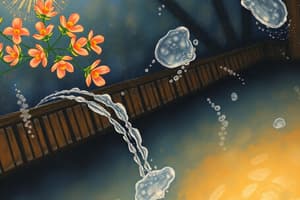Podcast
Questions and Answers
What is the net movement of molecules and ions from a region of their higher concentration to the lower concentration, as a result of their random movement?
What is the net movement of molecules and ions from a region of their higher concentration to the lower concentration, as a result of their random movement?
- Active Transport
- Passive Transport
- Diffusion (correct)
- Osmosis
What is the main energy source for diffusion?
What is the main energy source for diffusion?
Kinetic energy
Diffusion can only occur in liquids.
Diffusion can only occur in liquids.
False (B)
Which of the following is NOT an example of where diffusion occurs in living organisms?
Which of the following is NOT an example of where diffusion occurs in living organisms?
What does the rate of diffusion depend on?
What does the rate of diffusion depend on?
Match the following factors affecting the rate of diffusion with their respective descriptions:
Match the following factors affecting the rate of diffusion with their respective descriptions:
What is the net movement of water molecules from a region of higher water potential (dilute solution) to a region of lower water potential (concentrated solution) through a partially permeable membrane called?
What is the net movement of water molecules from a region of higher water potential (dilute solution) to a region of lower water potential (concentrated solution) through a partially permeable membrane called?
What kind of membrane allows water to move through, but not larger molecules like sugar?
What kind of membrane allows water to move through, but not larger molecules like sugar?
A dilute solution (where there is a lot of water) has a low water potential.
A dilute solution (where there is a lot of water) has a low water potential.
What happens to an animal cell placed in pure water or a dilute solution?
What happens to an animal cell placed in pure water or a dilute solution?
What happens to an animal cell placed in a concentrated solution?
What happens to an animal cell placed in a concentrated solution?
What is the name of a solution that has the same water potential as the cytoplasm of blood cells?
What is the name of a solution that has the same water potential as the cytoplasm of blood cells?
What happens to a plant cell placed in pure water or a dilute solution?
What happens to a plant cell placed in pure water or a dilute solution?
What happens to a plant cell placed in a concentrated solution?
What happens to a plant cell placed in a concentrated solution?
Active transport requires energy from respiration.
Active transport requires energy from respiration.
What is the process by which plant cells absorb minerals from the soil?
What is the process by which plant cells absorb minerals from the soil?
Which of the following is NOT an example of active transport in humans?
Which of the following is NOT an example of active transport in humans?
Flashcards
Diffusion
Diffusion
The movement of molecules or ions from a region of higher concentration to a region of lower concentration, along the concentration gradient.
Kinetic Energy
Kinetic Energy
The energy source for diffusion.
CO2 Diffusion in Plants
CO2 Diffusion in Plants
The process in which carbon dioxide needed for photosynthesis enters leaves through stomata.
O2 Diffusion in Plants
O2 Diffusion in Plants
Signup and view all the flashcards
CO2 Diffusion in Plants at Night
CO2 Diffusion in Plants at Night
Signup and view all the flashcards
O2 Diffusion in Plants at Night
O2 Diffusion in Plants at Night
Signup and view all the flashcards
Gas Exchange in Animals
Gas Exchange in Animals
Signup and view all the flashcards
Food Absorption in Animals
Food Absorption in Animals
Signup and view all the flashcards
Temperature's Effect on Diffusion
Temperature's Effect on Diffusion
Signup and view all the flashcards
Concentration Gradient's Effect on Diffusion
Concentration Gradient's Effect on Diffusion
Signup and view all the flashcards
Surface Area's Effect on Diffusion
Surface Area's Effect on Diffusion
Signup and view all the flashcards
Distance's Effect on Diffusion
Distance's Effect on Diffusion
Signup and view all the flashcards
Osmosis
Osmosis
Signup and view all the flashcards
Water Potential
Water Potential
Signup and view all the flashcards
Partially Permeable Membrane
Partially Permeable Membrane
Signup and view all the flashcards
Endosmosis
Endosmosis
Signup and view all the flashcards
Exosmosis
Exosmosis
Signup and view all the flashcards
Turgor Pressure
Turgor Pressure
Signup and view all the flashcards
Turgid Cell
Turgid Cell
Signup and view all the flashcards
Flaccid Cell
Flaccid Cell
Signup and view all the flashcards
Plasmolysis
Plasmolysis
Signup and view all the flashcards
Water Absorption in Plants
Water Absorption in Plants
Signup and view all the flashcards
Active Transport
Active Transport
Signup and view all the flashcards
Transporter Proteins
Transporter Proteins
Signup and view all the flashcards
Mineral Absorption in Plants
Mineral Absorption in Plants
Signup and view all the flashcards
Glucose Absorption in Humans
Glucose Absorption in Humans
Signup and view all the flashcards
Glucose Reabsorption in Humans
Glucose Reabsorption in Humans
Signup and view all the flashcards
Study Notes
Chapter 3: Movement into and out of Cells
- Diffusion: The net movement of molecules or ions from an area of high concentration to an area of low concentration, driven by random movement and kinetic energy.
- Diffusion is important for gas exchange in organisms (e.g., CO2 and O2).
- Factors affecting the rate of diffusion:
- Temperature: Higher temperatures increase kinetic energy, increasing the rate.
- Concentration gradient: A larger difference in concentration speeds up diffusion.
- Surface area: A larger surface area increases the rate.
- Distance: Shorter distances lead to faster diffusion.
- Osmosis: A special type of diffusion, involving the movement of water molecules across a partially permeable membrane from a region of high water potential to a region of low water potential.
- Water potential is the measure of the tendency of water to move from one area to another.
- Dilute solutions have higher water potential.
- Concentrated solutions have lower water potential.
- Osmosis in Plants: Cells in pure water absorb water and swell, but cell walls prevent bursting. In concentrated solutions, water leaves the cell, causing it to become flaccid (limp) or plasmolysed (cell membrane pulls away from cell wall).
- Osmosis in Animals: Animal cells in pure water burst. Cells in concentrated solutions shrink. Cells in an equivalent solution maintain their shape.
Active Transport
- Active transport moves substances across cell membranes against their concentration gradient, requiring energy from respiration.
- Active transport is crucial for:
- Absorption of minerals by root hair cells.
- Glucose absorption in the small intestine.
- Glucose reabsorption in the kidneys.
- Specialized protein transporters in cell membranes facilitate this process. These proteins change shape to move substances across the membrane.
Studying That Suits You
Use AI to generate personalized quizzes and flashcards to suit your learning preferences.




